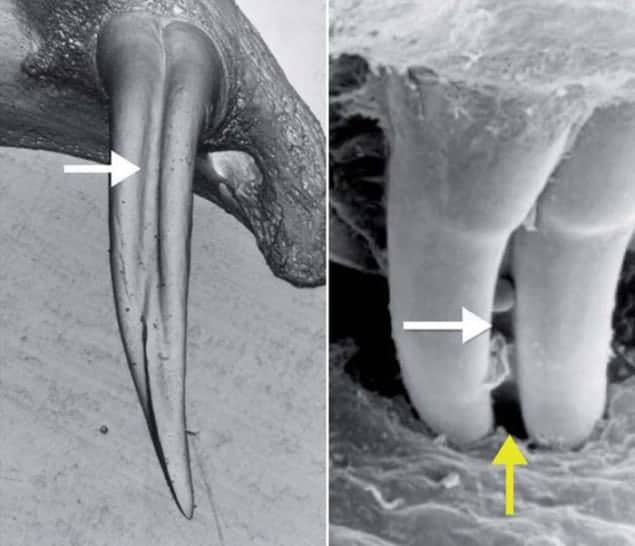
If you are ever unlucky enough to have a snake sink its fangs into your leg, then you might take a second to marvel at the clever mechanism behind its venom delivery. Indeed, according to biophysicists in Germany and the US, many venomous reptiles do not inject their poison, as you might think. Instead, they rely on a toxic mix of surface tension and “tomato ketchup” physics. “Until we did, nobody had ever bothered about the question of why snake envenomation happens the way it does,” says team member Leo van Hemmen of the Technical University of Munich.
A few snakes do inject their venom, the rattlesnake being a well-known example. A rattlesnake’s fangs are like hypodermic needles, shooting venom into prey at high pressure from a poison gland in the snake’s head. But many venomous snakes and other reptiles do not have tubes in their fangs, and so cannot deliver pressurized venom. Often their fangs just have a single groove, running top to bottom.
Hydra-dynamics
Van Hemmen and his colleagues at Munich together with Bruce Young at the University of Massachusetts wanted to understand whether these grooves help in the venom delivery. To do so, the researchers milked some venom from a pair of snakes, then mixed it with equal parts of saliva, as would usually happen. Next, they measured the venom–saliva mixture’s viscosity for different values of shear rate – that is, the viscosity of the venom when it is between two surfaces that are moving relative to each other at a certain rate.
This process revealed an interesting fact about snake venom: it is a bit like tomato ketchup. Unlike water, which flows regardless of the forces acting on it, ketchup gets less viscous – or more able to flow – as the shear forces acting on it increase. This trait makes ketchup a “non-Newtonian” fluid.
Van Hemmen’s group believes snake venom’s non-Newtonian behaviour is integral to its delivery. When the venom is in the fang grooves, exposed only to air, the lack of shear forces means that it has a high viscosity. However, when the fangs penetrate skin, the shear forces increase, the viscosity decreases, and the venom can flow freely.
Surface tension draws venom
But there is more to a snake bite than non-Newtonian physics. Van Hemmen’s group also measured the venom mixture’s surface tension, a property that acts to minimize surface area and energy – by forming a fluid into droplets, for example. The researchers then used computer software to analyse how surface energy would be minimized in different groove shapes. In general, the researchers found that when the fangs are in air, surface tension keeps the venom in the groove. However, when the fangs penetrate flesh, the grooves and tissue form a tubular shape that increases surface area and minimizes surface energy, thereby drawing the venom in.
“I find this a very interesting study,” says Wolfgang Wüster of Bangor University in Wales, who is a biologist and expert on venomous snakes. “For many years, biologists have wondered about the function of the grooved rear fangs of many snakes. As a delivery system, it has often been dismissed as inefficient…This new study shows that a grooved fang is in fact an effective venom-delivery system that can introduce toxins into a bite wound fairly rapidly and effectively.”
However, Kenneth Kardong, a biologist who studies reptiles at Washington State University in Pullman, US, is not convinced that the grooves are there to deliver venom. He says the secretions of reptiles are a “cocktail of chemicals” with a variety of functions, including digestion. Although “the physics is interesting” , he says, the grooved fangs may only shift the fluid to the prey’s skin, and not further down, directly into the prey’s bloodstream where it would be most effective as a poison. “All roads may lead to Rome, but not all reptile secretions lead to venom,” he adds.
Even if grooved fangs are an efficient deliverer of venom, evolution suggests that they are probably not as effective as the rattlesnake’s tubular fangs. Hans Sues, a palaeontologist at the Smithsonian National Museum of Natural History in Washington, DC, has performed studies revealing that enclosed tubes developed from open-grooved fangs in reptiles during the Triassic period, more than 200 million years ago. “Such a transition had long been hypothesized as the tubular fangs in snakes develop by infolding during embryonic development,” he says. “Thus, despite the efficacy of open grooves, there was still development of fully enclosed canals.”
The research is published in Phys. Rev. Lett. 106 198103.



